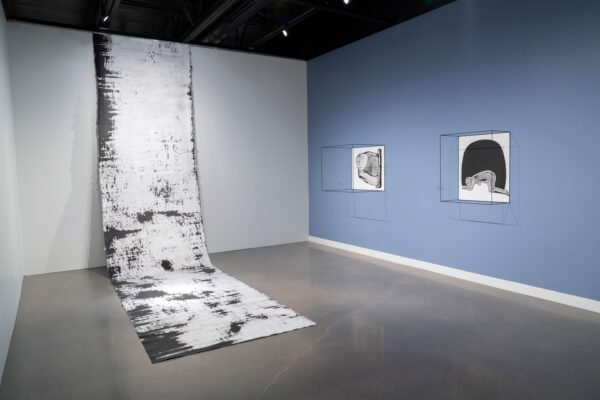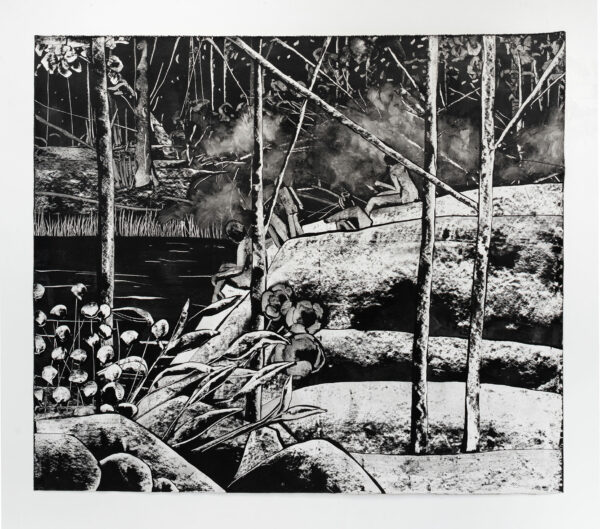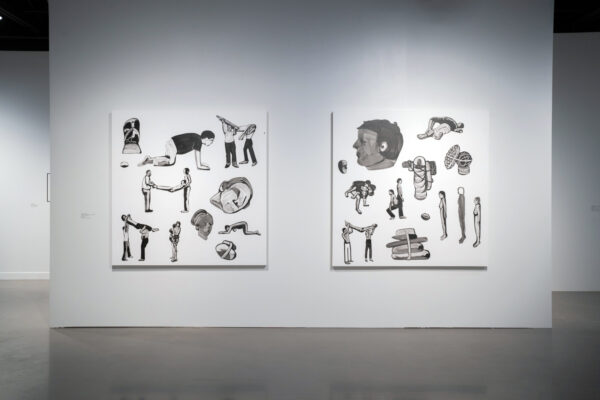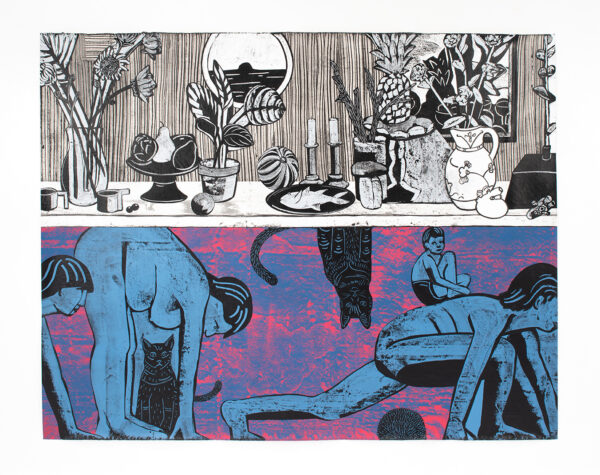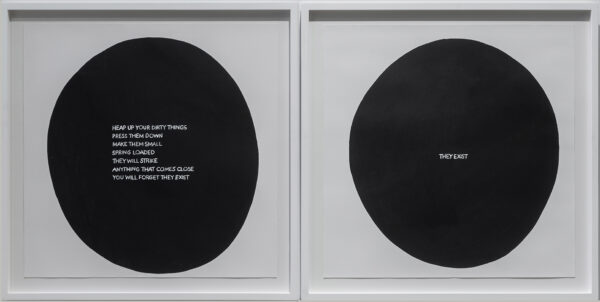Four of us went down to Las Cruces for Joey Fauerso’s opening on June 10. A few days later I sent Joey some questions.
Hills Snyder (HS): Is your work cinematic?
Joey Fauerso (JF): This is a good question. What do you think? I would hope that some of the pieces function that way. When I think of something being cinematic, I think of a transportive experience, something that is immersive and uses scale to trigger an emotional, physical experience in the viewer. I recently saw Ryûsuke Hamaguchi’s film Drive My Car in the theater with my brother, Neil. It was such a beautiful movie; the sound design blew me away, you physically felt like you were inside of the scenes, sometimes inside of the body of the characters, almost like some of Janet Cardiff’s sound installations. With my video works, I love the editing process — the rhythm and orchestration of editing across multiple screens. I guess in all of my work, the physicality is really important. A lot of my work resides at the intersection of painting and performance. One of my favorite all-time works is Jasper Johns’ painting Bitten by a Man from 1961; it is so direct and immediate, it feels like it just happened, and that maybe you were the one who took the bite. Getting back to the cinematic, I would like to continue to push the scale of my work, both with the videos and paintings.
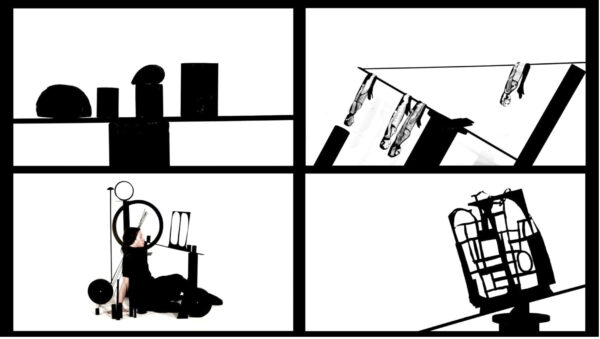
Joey Fauerso, “You Destroy Every Special Thing I Make,” 2017-2019, 4-channel video, 10:00. View the piece here.
HS: My question was spurred by those wall-mounted pieces that project the frame of the piece outward toward the viewer via an oblique three-dimensional drawing made of quarter-inch painted steel rod. They read as tiny theaters, drawing focus from the viewer. The one I’m picturing features the profile of a leg, cut off by the frame or seemingly slid-in to a thin space as in a magic trick. For me, cinema is about a camera enclosing my vision in its point-of-view. I’m thinking right now of the way Altman likes to linger on a peripheral object in a scene just as the action is leaving that scene for whatever is next. This is the camera sharing insight with the viewer, as if we in the audience are being shown the elephant in the room, even as it remains invisible to the characters. Additionally, these frames of yours are almost like a two-point perspective invitation to look into a stereopticon. So yes, I think your work is cinematic.
I have to wonder if the sensuous qualities of molten encaustic might have been what invited Jasper Johns to bite that painting, possibly as you say, spontaneously. In this bite, I see a kiss given to Francis Bacon’s Head VI, 1949, which incidentally also features that oblique linear cube enclosing the image of the figure, a framing device quite similar in construction to your three-dimensional version made of quarter-inch rod.
JF: Oh man I was just looking at Bacon’s Head VI — what a beautiful and terrifying painting. It reminds me how influential he is to so many artists now and throughout the second half of the 20th century. Also, I love what you wrote about the painting being a kiss and a bite, that is a wonderful, complicated image. I think your point about the cinematic framing of a subject, the lingering and drifting which creates a point of view shared by director and audience, is so interesting. Framing has been something I have been thinking a lot about in both the paintings and the videos — how a frame creates both a physical and psychological space to absorb the work, and also how the frame can in some cases become the central subject of the work. An inversion of subject and ground. One of my favorite poems is Mark Strand’s “Keeping Things Whole.”
In a field
I am the absence
of field.
This is
always the case.
Wherever I am
I am what is missing.
When I walk
I part the air
and always
the air moves in
to fill the spaces
where my body’s been.
We all have reasons
for moving.
I move
to keep things whole.
I’m also glad you brought up magic tricks. Do you know that one of the early versions of the magic trick where a woman is sawed in half was titled “Modern Art?” I keep thinking about that…
HS: I didn’t know about Modern Art so I looked it up and found this:
“Modern Art is described and detailed in Steinmeyer’s booklet Modern Art and other Mysteries. Owners of this book are authorized to build and perform this illusion.”
This was very revealing to me, as I’ve been wondering what kind of stuff the Texas Governor reads — the women that participated in Modern Art are sawed in half while standing.
That Mark Strand poem could be like the riddle of the Sphinx — what kind of container shrinks as its contents enlarge?
In your videos in which assemblies of components are falling apart, what is falling apart?
JF: The individual elements are not falling apart; and the performers and participants in the videos are not falling apart; what is falling apart are the compositions — the set ups of individual elements creating a structure or image that at first seems stable and fixed, but actually exists in a state of continual precarity, on the verge of collapse. The arrangements of blocks and paintings are graphically so strong because of the high contrast black and white, but they are actually really delicate and fragile. Those pieces hopefully function on several levels, but personally for me that work springs from my own experience being diagnosed with breast cancer in my thirties, when my kids were young. Life swung into such chaos and instability so quickly, and then had to be reassembled under new conditions. Uncertainty, precarity and chaos, I think, are right at the center of the human condition. We have all certainly been experiencing this the last couple of years.
HS: Disease is among the roughest of lessons. There are many to be had in our accumulations of loss. There is so much more to living a life than living through it, and there is more to it than making do with what is left. It’s almost as if the appurtenances are just props, concealing a hidden purpose. Then, when the failures and the falls happen, something is revealed. Meanwhile, you are undeterred by the wobble in the screen, the blink in the sunrise. Which takes the most resolve — art, survival, motherhood? It is a rhetorical question because the comparison is absurd, but maybe there are different kinds of resolve.
JF: Those are really big universal themes, but I will answer in a very personal way that speaks to my experiences. For me, once you become a mother, it doesn’t really have anything to do with resolve. It is a change in conditions, like being thrown into a pool of water, there is no resolve to be in the water, you are just in it. You might be better or worse at swimming, but the experience of having children, and having them instantly be the central fulcrum of your life, is pretty dramatic and irreversible. The resolve to survive exists within the shadow of motherhood, because from the moment you become a mother or parent, you understand how much your child needs you. Your kids are older, does that feeling change once they are grown?
I think making art requires huge resolve. It’s kind of like ice-fishing. You know there are fish swimming below the ice, but to gather all of your gear, bundle up for the cold, drill a hole, cast your line, and sit in the cold waiting to feel a pull requires a lot of resolve and a great love of ice-fishing. And you don’t always catch a fish, and often no one cares if you do! Full disclaimer, I have never been ice-fishing. This answer is dedicated to my good friend, cellist and ice fisherman Charles Lee.
HS: The connection is lovely, but I would not call it need. Your thrown-into-water comparison is right on target though, as is survival existing in the shadow of parenthood, though there is some irony in that one — knowing your life is being viewed by your kids is like being in a room with the lights on all the time. When you hear words of gratitude from a child for having an unconventional childhood, that is even more light to bask in, so I guess the shadow comes and goes.
I like the idea of ice-fishing, though I’ve also never been. Sitting around a hole in the ice, cultivating silence, observation, and patience, sounds a lot like sitting around a fire, a true pastime — though I would walk all day if I had nothing to write, make or sing. Those are not pastimes and they do require resolve — especially if you’re tempted to walk all day.
You mentioned Drive My Car. I love how that movie does to you what the actor in the play in the movie says that Chekhov does to him. That performing his lines is terrifying. Chekhov’s texts are mentioned as drivers of illumination simply by reading them if you’re a psychic digger, or saying them if you’re an actor delivering his plots. Drive My Car does this too, piling simultaneity on revelation. It’s a slow burn, but by the time you’re the fourth person in the car with Yūsuke and Kōji in the backseat and Misaki driving Yūsuke’s Saab, the twisting into truth will include your own reflections. This only intensifies when later in the film, Yūsuke and Misaki do a day-long drive to the location of her childhood home which was destroyed by a landslide when she was young. I identify with this crawling from the wreckage in which reference and association come smack up against self-recognition and honest looks within.
At this point in our conversation, I returned to Joey’s show for a second visit and had a chance encounter with the museum’s Director, Marisa Sage. She came into the gallery and was overflowing with her support for the exhibition and what it was giving:
“I’ve just been coming into the museum and to this gallery every day to kind of cope with what’s been going on in our country since they overturned Roe vs. Wade, and looking at the strength of these women. Every single woman that she depicts — these mothers, these other artists, these thinkers, these doers, these women who build collectives — I’m struck and I’m reinvigorated in my belief in women every time I come into this space.
Knowing Joey, not only a mother, an artist, a thinker, a reader, but she is so inspired by many other women artists, women thinkers and women doers; and she is inspiring a whole other generation of women artists, thinkers, and doers. As a teacher at Texas State and as a mentor, there is not a woman artist in San Antonio that doesn’t talk about Joey. She is just what I believe our future of women to be. I’m just inspired by her art — it’s so beautiful and so strong and just shows the strength and that we will fucking overcome.”
HS: Your figurative paintings have a look — simultaneously like xerox copies and solarized photography, as if mitigation is the handle, as opposed to straight-up documentation. Would you mind speaking to how you evolved this form of representation?
JF: I have always painted in a subtractive way-using rags, brushes, and solvents to wipe away and reveal the underlying surface. In 2014 I stopped using oil paint due to concerns over toxicity and started using acrylic. The paint had such a different feel, and I knew I had to come up with a new way to build an image, not just try to paint the way I did with oils, because it wouldn’t really work. I started to develop a subtractive method of primarily monochromatic painting in which I would cover the entire surface of the canvas or paper with paint, and then scrape away the paint to build or carve out the image. I use a variety of different tools — rubber spatulas, silk-screen squeegees, and other non-traditional implements that I have experimented with over the last eight years. Oftentimes, I paint on the floor, so the texture of the floor of my studio becomes a kind of indexical print embedded in the imagery. The resulting paintings have a quality that positions them in a place between traditional mediums. They feel sort of like wood-block prints, two-dimensional carvings, daguerreotypes, sometimes drawings. They are also very sculptural to me; they sort of look like they are carved out of stone.
HS: Wait for It, the title of your exhibition, appears to be borrowed from Jenny Browne, clearly honoring your friendship and acknowledging her creative energies. I suspect there are other alignments there. Care to comment?
JF: Actually, it was the reverse. I titled the exhibition that opened at the Visual Arts Center at the University of Texas in Austin Wait for It, and then we asked Jenny to write a poem and short essay in response to the show. The show is built around the many experiences and interpretations of waiting, both as a place of anxiety and a place of speculation, and a place for dreaming. Jenny’s beautiful poem was in response to a painting titled The Waiting Room that isn’t included in the NMSU show, but we loved the poem so much, we wanted to include it in this version of the show as well. But to your larger question, Jenny is an ongoing collaborator, and a real creative inspiration in my life. We have been friends for a long time, and share many experiences-as artists, mothers, and teachers. I am always looking for a reason to work together.
HS: The titles of your pieces are frequently oblique, as if the words are caught in ricochet off the images. Is this where your meanings lie, in some form of crossfire?
JF: Yes, I love that imagery so much. The titles are often in conversation with the pieces, but hopefully do not pin them down too much. Sometimes I start with a title, like with You Destroy Every Special Thing I Make or Under the Table, and sometimes the title comes later. If a good title doesn’t come to me, I like to go a very direct route like Laeree With Flowers, or in the case of that big head, it’s just titled A Head. But I love language and poetry, so the process of thinking through titles is really enjoyable.
HS: Holding Patterns 1 and 2 suggests a repeating iconography of helping, lifting, holding, crawling, bundling, maybe even severing…but all the images float in a white space that leaves connections ambiguous. This is generous to the viewer, lots of room in that open space, inviting personal interpretation. What is your version?
JF: You touch on something important here, which is that one of my key working methods is to create a collection of disparate imagery that is held together by a loose theme, in this case contrasting imagery of togetherness and isolation, and of dreams of escape. I think these were dominant experiences for many of us during the pandemic — loneliness for some and crushing claustrophobia for others. But for almost everyone there was a desire to escape circumstances outside of our control. I like to mix the personal and historical, so in these paintings you see images of my brother and his friends lifting each other, sculptures made by my sons of rocks pressed together like bodies wrestling, and paintings of myself and my kids. But there are also paintings of Mary Queen of Scots; a twelve-thousand-five-hundred-year-old carved wooden head discovered in a peat bog in the Ural Mountains; and the Paper Mache heads made by Frank Morris and the Anglin brothers to place in their beds when they escaped from Alcatraz. I’m kind of obsessed with those heads, they made them using toilet paper and hair-clippings from the prison barber. In another part of the show there is a small monoprint of Frank Morris — he was the mastermind of the Alcatraz escape. He was such an interesting and complicated person from what I have read.
HS: Under the Table. That’s where you go when someone drinks you there, but on the table, there is a parade of items — coffee cup, fruit in a bowl, potted plant, fish on a platter, watermelon, candlesticks, flower arrangements… Then, a heart out of body, rather nonchalantly joining the tableau of what are otherwise rather mundane items. Then, under the table, that’s where the color is, where the work of holding a family together happens, where the cats play, where I lie, drunk on your images, again caught in the crossfire.
JF: Yes, this was one of those paintings where the title came to me first. I was thinking about the idea that a lot of the most interesting stories and the most dramatic events are hidden from view, this has certainly been the case with most women’s lives up until very recently. Almost everything took place “under the table.” Have you ever seen pictures of Catherine the Great’s erotic furniture? I love it so much, there is a table that looks pretty traditional from above, but underneath there are huge penises and breasts. Catherine the Great was a master of concealment. Another recurring strategy in my work is to try to shift the conventions in traditional genres of painting, while still using those genres. So, in this case the still life — which is very still — is just the outer crust. As you point out, there is a much weirder, wilder, freer and more colorful world taking place below.
HS: I have to wonder if Catherine the Great first conceived of her erotic furniture while being erotic on furniture. Or maybe she was underneath, projecting. Everyone leaves an erotic imprint on the planetary memory — maybe she needed to manifest hers concretely. At any rate, that teeming energy as the hidden support of a conventional surface seems to point at how the baroque is the over-culture unconsciously attempting to take its clothes off — but that conventional surface keeps trying to polish its way into dominance, even though it is eros that is the actual engine of anything moving or evolving. So eros meets resistance — there was a beloved ceramics artist at Texas Tech and later at UTSA, Steve Reynolds, who came to Lubbock from Odessa where he’d been teaching and there was a story about how his multi-breasted ceramic nun-vessels had drawn the ire of some Odessian who had shot at his house with a shotgun.
I guess I’m relating your various subtraction strategies to the cultural process of stripping back the crust to a greater reveal, and how this is alarming to aspects of the culture; giving us the current dynamics of containment mixed with sudden explosions of violence.
JF: Yes, I definitely think that’s one of art’s most important jobs — to reveal the hidden currents, to “strip things back” as you say, to push against the conventional surface of things. Your thoughts on this topic reminded me of a painting/poem I made in 2016 titled Cottonmouth.
Wait for It
The wall tried hard
to frame paradise.
The black dog waits
for his door to open.
The boulders win
their staring contest
with the blossoms.
Some will wonder
how long it lasted.
Some will wake
to sirens then silence.
Some wanted to be
followed by the sound
of their own howling.
Watch how she imagines
herself a boarding pass
to anywhere waves
crash without asking
or having to ask.
-Jenny Browne, August 2021
Wait for It, at the New Mexico State University Art Museum, Las Cruces, New Mexico, continues through September 2, 2022.




